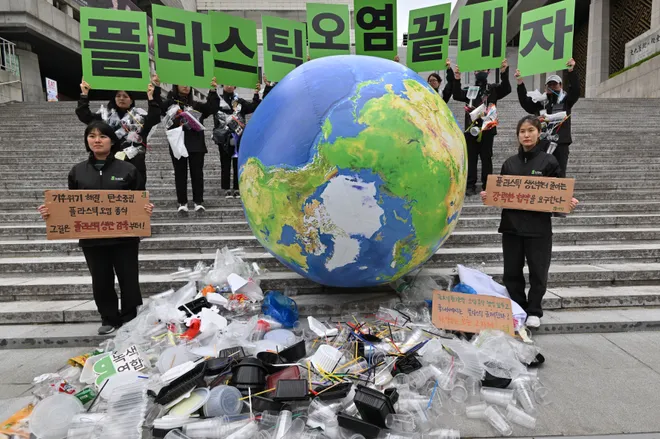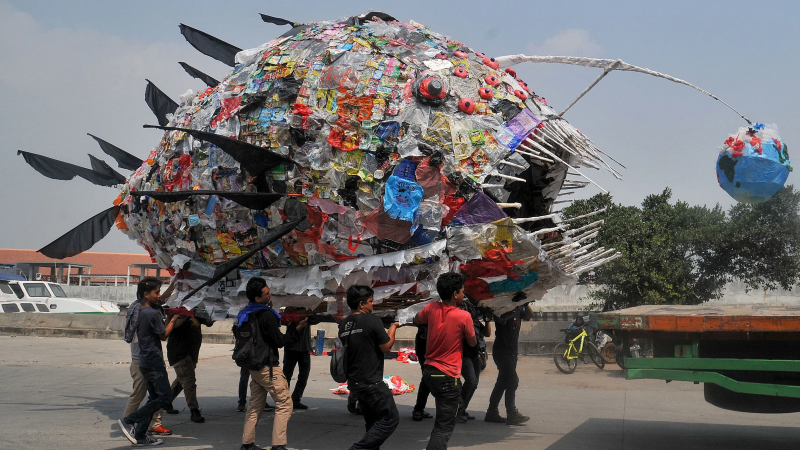Earth Week underway as UN committee debates plastics and microplastics. Here's why.
On the eve of an international meeting to debate a global treaty on plastic pollution, Earth Day 2024 on Monday highlighted the planet's growing problem with plastics in events ranging from beach cleanups and seminars to an environmental demonstration in Seoul, Korea.
Since the first Earth Day in 1970, plastic has become more ubiquitous in our environment. It's now considered "a crisis of global proportion," according to the United Nations' Intergovernmental Committee to Develop an International Legally Binding Instrument on Plastic Pollution, including in the Marine Environment.
"This is right there with climate change as a primordial threat to the planet," pediatrician Leonardo Trasande, a researcher and professor at New York University, told journalists at the Society of Environmental Journalists meeting in Philadelphia earlier in April.
Billions of bits of plastic infiltrate waterways and oceans, are consumed in beverages and food and are found in the internal organs of people and wildlife. A 2023 paper published by the National Library of Medicine, and others, show microplastics can wreak havoc on hormones and contribute to a range of health problems.
In the lead up to Earth Day 2024, EarthDay.org organizers promoted the theme "Planet vs. Plastics," calling for a massive reduction in plastic production and the waste stream and urging people to sign a petition backing the treaty. Additional Earth Day events are planned throughout the country.
On Tuesday in Ottawa, Canada, the UN committee begins a weeklong session to try to come to an agreement on a draft agreement on plastics in the environment. It’s the fourth such meeting since 2022, when the UN agreed to develop a treaty to try to curb the flow of plastics into the environment.
Here's a breakdown of some of the key terms and major issues expected to be discussed:

What is microplastic?
Plastic has been found in every corner of the world and has turned up in drinking water, beer, salt and honey, according to Oceana, an ocean conservation group. While some may think of plastic pollution as plastic shopping bags or soda bottles, it's the tiniest particles – microplastics and nanoplastics – raising big concerns.
Microplastics for example are tiny particles of polymers less than five millimeters long, no bigger than a grain of rice. They come from plastic bottles, synthetic clothing fibers, car tires and other products as plastics break down slowly.
Anika Dzierlenga, a program lead at the National Institutes, said: "We know very little about what these microplastics or even smaller pieces of plastics, known as nanoplastics, can do to human health in the short-or long-term, or even what they can do to the health of the sea turtles and other animals that live in the ocean."
What are nanoplastics?
Nanoplastics are even smaller, only one-billionth of a meter, according to the National Nanotechnology Initiative. By comparison, a strand of human DNA is 2.5 nanometers in diameter and a human hair is approximately 80,000 - 100,000 nanometers wide, the Initiative states.
How has the use of plastics increased?
The annual production of plastic, including polymer resins and fibers, increased from 2 million tons in 1950 to 459.75 million tons in 2019, according to Our World in Data, based on a 2023 paper about plastic production published in the journal Science Advances. By 2022, estimates suggest plastic production exceeded more than 400 million tons.
Estimates suggest that less than 10% of plastic waste in the U.S. is recycled, while a majority heads to landfills.

How can plastics be harmful?
Plastic and the particles it produces can be found from the Arctic tundra to the deepest oceans, according to the U.S. Environmental Protection Agency and the UN. It includes everything from large items such as bottles, jugs and plastic bags floating in the ocean and washing up on beaches to the particles that a recent study found may be linked to an increased risk of heart attack, stroke and death.
One study found bottled water can contain 10 to 100 times more plastic bits than previously thought, while other studies have found microplastics in clouds, rain and in the placentas of pregnant women.
For some, the bigger concerns beyond the tide of plastic bits are the chemicals and contaminants they carry that have been linked to endocrine disruption and other abnormalities in the human body and the harmful fossil fuel emissions from the production of plastic.
Studies show that microplastics accumulate chemicals and pathogens on their surfaces. "Microplastics are likely the drug delivery system," Trasande said. "It's the chemicals riding them that are causing the damage."
What will the plastic treaty discussions include?
The UN committee is scheduled to discuss polymers, waste management, trade, pollution, financing and technology as it tries to reach agreement among the world's governments, in an effort similar to the talks in Paris in 2015 that produced the global treaty on climate change.
Reuters has reported that many plastic and petrochemical-producing countries, including China, Saudia Arabia and Iran do not support language in favor of production limits.
Last week in advance of the treaty talks, the American Chemistry Council, a trade industry for chemical manufacturers in the U.S., released a study by Oxford Economics which concluded a production cap on virgin plastics would carry "major economic costs."
The study, commissioned by the International Council of Chemical Associations, concluded the implementation of a "proposed plastics production cap would have unintended global implications going beyond the plastics industry."
In a webpage on plastics and the treaty, the State Department said the U.S. supports development of "an ambitious global agreement on plastic pollution that has universal obligations throughout the lifetime of plastics."
What about plastics in the ocean?
A major focus of the proposed international treaty is plastic in the marine environment.
Millions of tons of microplastics – ranging from the size of a width of a pencil to smaller than a sesame seed – find their way into oceans, according to the National Institutes. The particles move through the food chain to people and they also attract pollutants and carry them into new environments.
An estimated 33 billion pounds of plastic wash into the ocean every year – about two garbage trucks worth of plastic every minute, according to Oceana. The group has cited a nationwide poll conducted by Ipsos in December 2022 that showed 83% of American voters are concerned about single use plastic products and 73% support a pause in building new plastic production facilities.
April Burt, a conservation scientist with the University of Oxford, said her work in the Seychelles, an archipelago in the Indian Ocean off Africa, highlights “the vast accumulation of marine plastic pollution bombarding the islands from both at-sea and international sources.”
But it's not too late to stem the flow, she said. “The global plastics treaty gives us the opportunity to turn the tide on plastic pollution, from policy on the manufacture of plastics, to retailer responsibilities and dealing with legacy plastics."
Contributing: USA TODAY reporters Elizabeth Weise and Doyle Rice
Dinah Voyles Pulver covers climate and the environment for USA TODAY. Reach her at dpulver@gannett.com or @dinahvp.
Disclaimer: The copyright of this article belongs to the original author. Reposting this article is solely for the purpose of information dissemination and does not constitute any investment advice. If there is any infringement, please contact us immediately. We will make corrections or deletions as necessary. Thank you.





